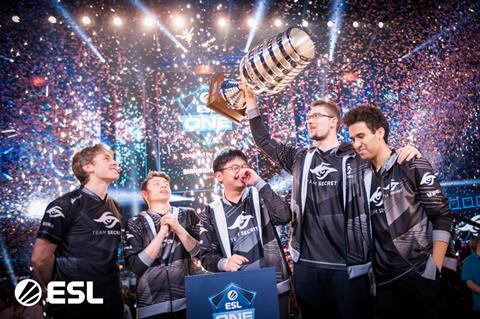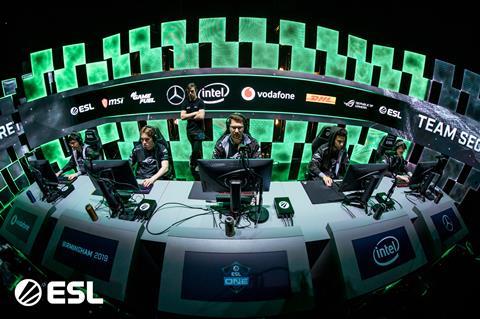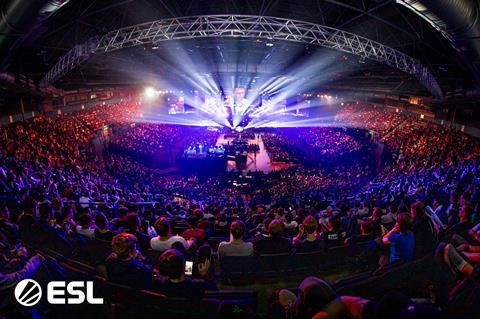The nascent esports industry is one of the fastest growing sports markets in the world. But millions of engaged viewers bring with it growing expectations. IBC365 goes behind the scenes at a Dota 2 tournament and speaks with industry experts on broadcaster’s opportunities to monetise, engage and deliver.

Traditional broadcasters are uniting sports, gaming and technology to tap into new markets and drive new avenues of revenue capitalising on the vast prospects presented by the esports industry.
Dota 2 International has raised $100 million in crowdfunding and this contributed to a $25 million prize pool in 2018 and viewership figures in the multi-million region, with audiences eager to contribute.
As IBC365 sits down with ESL UK managing director James Dean during the ESL One Birmingham Dota 2 tournament, he explains that there is a lot of interest from traditional broadcasters but says the lack of understanding on how esports can be monetised must be overcome in order to compete with digital platforms and millennials users opting for smart interactive services.
Dean says: “As a service, how do you define broadcast? The method of sending a video image to a TV or broadcaster delivering a story are deemed one of the same but there needs to be a business model behind it and the media rights are growing for esports.”
Esports has seen great success from native streaming services. Dean believes the integration of technology will bring similar success for broadcasters.
He adds: “The audience is willing to contribute so we need to wrap around the main broadcast and have more personalised digital delivery techniques including artificial intelligence (AI) driven content machine learning (ML) to create immersive experiences.
'IT'S A DISASTER!'
— ESL Dota2 (@ESLDota2) 2 June 2019
Game 5 starts with a BANG! 💥
🇬🇧 https://t.co/RUTJQiyOsP pic.twitter.com/08tTn1q6Fo
“Sensorial emotional and cognitive in-depth analytics are key to give more to viewers and fans than what they’re receiving now. It is about the social immersion and sharing of team success and challenges and ultimately being able to share a personalised message to every individual.”
Esports has grown in a “rapid manner,” Dean adds, describing the industry’s success: “There was no shortage of people playing games or competing but there wasn’t a broadcast element in the early 2000’s.”
He continues: “A lot of these productions would be broadcast on the internet through software or PC hardware with decklinks and capture casts. HDMI cameras basic with live output and software OBS would exploit free-to-use streaming software and pull together a basic broadcast reaching 20 thousand viewers.”
Whilst the traditional esports business model has evolved, the broadcast industry has been slow on the up-take. One of the greatest developments was in 2015 when Twitch was bought by Amazon for $1 billion a this, Dean explains, marked the industry’s first major evolution.
Today the demand in viewership drives revenue. In 2018 esports revenue totalled $869 million and this is forecasted to more than triple by 2022, reaching $2.9 billion according to an October 2018 report by Goldman Sachs.
While PwC estimates that over the next three to five years, media rights revenue would grow 11.5%—to roughly $449 million by 2022. That’s more than twice the growth rate of sponsorship and advertising, at 5.5%.
Dota 2
Dota 2 was the first esports discipline to have a prize pool in excess of $1 million at the International 2011 championship.
The ESL One Birmingham event held last week hosted 12 teams to battle in the five-game Dota 2 series where Team Secret won the series against Evil Geniuses.
Organisers told IBC365 it was a smaller scale event, notwithstanding impressive viewing numbers with a total of 13,393,547 views across all channels including Twitch, Facebook, YouTube and Dota TV – the channel dedicated to the game.
Excluding the rebroadcast transmission, the total airtime of the tournament was 63 hours with a winning prize pool of $300,000.
Customising the connection
ESL One Birmingham was composed on an EVS DYVI vision mixer, while several events often employ the Atem within the in-game setup it was also used in the chain as a backup.
ESL UK technical manager Matt Evans explains the technical complexity of the workflow and the requirement to integrate multiple vendor equipment including Blackmagic Design, Ross, EVS, Decimator Design, PI Engineering, Sam and Riedel.
On the bespoke workflow, Evans says: “In game content seen at the event was captured to SDI from a number of observer PC’s and composed on an ATEM with its associated overlays and graphics this was then passed to our primary switcher used at the event provided by our OB partner.”

It is difficult to ascertain how many Quad2 & Decklink cards are used in the workflow, he adds.
“For example, just one rack of many used at the event has 10 Decklink cards, a Multivew4, a Teranex AV, a number of converters to provide just one component used in the broadcast.
“We are also one of the few companies globally that build our own custom Ross Xpression hardware using Blackmagic Design hardware to get the feature set we need for our broadcasts.”
Traditional broadcasters take esports mainstream
In June 2016, Sky and ITV joined up with sports channel Ginx to launch Ginx Esports TV, an international, 24-hour station. The BBC, ESPN and BT Sport have also dabbled in esports have been broadcasting.
Last month at an event in London, Ginx chief executive Michiel Bakker confirmed it will launch a direct-to-consumer service set to launch the end of summer.
He said: “The platform will be bespoke and have gamification features to incentivise people to play.”
- Read more: Ginx takes esports direct-to-consumer
Dean explains the traditional job of an esports broadcaster was to get the game out to the fans. This was affirmed on the chat feature on Twitch where audiences were not interested in the commentators and demanded the action.

“The fan base grew in a different manner and teams and storylines became more important and production values evolved to see what we see more in the sports industry with more context around what is being played.”
Dean coined the term “OTT+” where he called for broadcasters to do more in terms of the players and statistics. He adds: “The game is crucial but the more we can do to explore the techniques for personalisation and delivering context is where the broadcast industry will succeed.”
Transforming the esports experience
Televising the esports game on digital platforms, including Facebook, YouTube and Twitch, is where the main viewership congregates with regional equivalents in the Asian region.
He adds: “Several countries will localise content and deliver through more traditional broadcaster.”
Last December 7Sports, a sports business subsidiary of ProSiebenSat.1, announced a joint venture with community platform eSports.com, to broadcast live esports competitions and highlights on ProSieben Maxx, 7Sports will use eSports.com. It confirmed its plans to distribute its digital content for the German, Swiss, and Austrian (GSA) market.
However, content partnerships are not enough, according to Dean, with the lighting, grading and high-end production qualities of esports broadcasting requiring an assessment of budget and technology to heighten the experience.
He explains: “End users won’t see a difference. However, a new augmented reality (AR) graphic will offer audiences value feel and positively impact of the end delivery of that experience.”
A new esports consortium called Weavr formed of six partners led by ESL UK and includes technology specialists including Rewind, Focal Point VR, Dock10, Cybula and York University in a focussed two-year project as part of the Industry Strategic Challenge Fund (ISCF), won a government grant to help drive audiences of the future.
- Read more: Esports consortium boosted with £4m grant
The grant aims to change the future of esports broadcasting with the consortium creating 45 technology focussed jobs which will help facilitate new immersive experiences for viewers and drive the launch of new platforms contributing to boost creative revenues.
Who is behind Weavr?
ESL will be focusing on the overall project management, utilisation of their esports events for proof of concept and the user experience feedback for those tests.
The University of York will be bringing its expertise in machine learning, UX design, Human-Computer Interaction and research into the convergent space between games, interactive media and TV to help sculpt the overall framework.
Dock10 will be providing its production facilities to help test the framework during ESL’s live esports events.
Focal Point VR will contribute its live 8k 360° video capture hardware & software, while Rewind is helping to create the VR and XR apps and environments for the viewer experience.
Catching up with IBC365 during the ESL One Birmingham tournament, Dock 10 head of production innovation Richard Wormwell explains the strategy behind the interactive app: “Weaver is an app, ambitious as it is a cross-platform, platform agnostic immersive experience.
“Our end goal is not exclusively around esports but will be taken into more traditional sports and entertainment experiences.”
Weavr lead analyst and University of York, DC Labs professor Anders Drachen adds: “One of the underlining elements is within esports and sports in general, a lot of data available but the way it is being used is very static.
“One thing Weavr is trying to do is establish how we tell stories with data and how do we empower audiences and stakeholders in esports and sports to use the data and tell their own stories.”
By October this year Weavr will have the first tailor made framework ready utilising AI in the back-end infrastructure.

Wormwell says: “This would not have been possible without the technology advances. The interactive application is designed specifically for the athletes and runs live real-time comparisons with historical data as it acquires data to examine the performance of the athletes and offer audiences an added layer to their viewing experience.”
While, most estimated agree around 2.5 billion people worldwide play games.
Drachen says: “This is across all age brackets and includes Candy Crush, Pokémon Go to World of Warcraft and Dota 2.
“Esports specifically has 280 million active viewers with a lot more also playing the game,” he continues. “This has exploded recently, and gaming has now overtaken the British film and music combine revenues.”
“Gaming and esports are a fantastic community, with the history of players and community. The ambition of Weavr is to provide a platform to put data in the hands of the creators, gamers and studios. But it is not just about big studio companies and broadcasters – we want to empower the players and audience’s broadcaster and organisers and everyone.”
Encouraging inclusivity
Esports has a growing community, but part of the appeal, Drachen explains, is the inclusive community which is open to everyone to play and support the games.
He says: “New controllers developed by Microsoft offer those with various disabilities the opportunity to play and to ensure the esports industry is inclusive and open to all in the future.
“It is a very attractive a noble aspect of the industry and the reason government and private funding grants are occurring, and we want to make sure the products are as inclusive as the environment we are building.”
IBC365 reported last year the esports business is on track to be a billion-dollar industry with millions of content partnerships, participants and viewers but industry leaders have called for more partnerships and government investment.
Interested in esports? Find out more during the IBC Esports Showcase at IBC2019
- IBC2019 takes place 13-17 September at the Rai, Amsterdam

























No comments yet